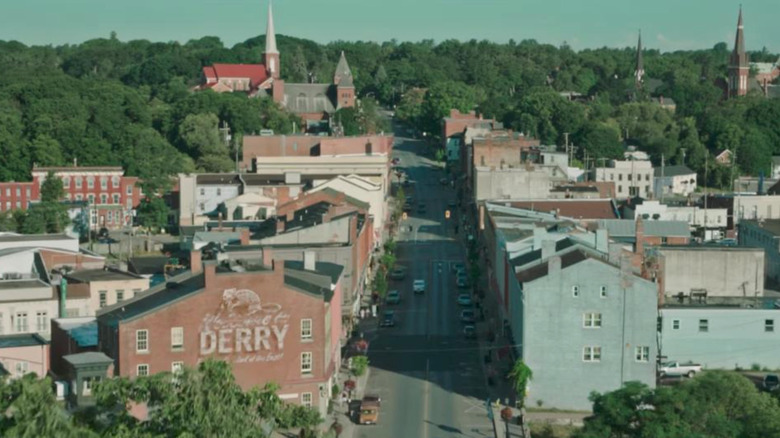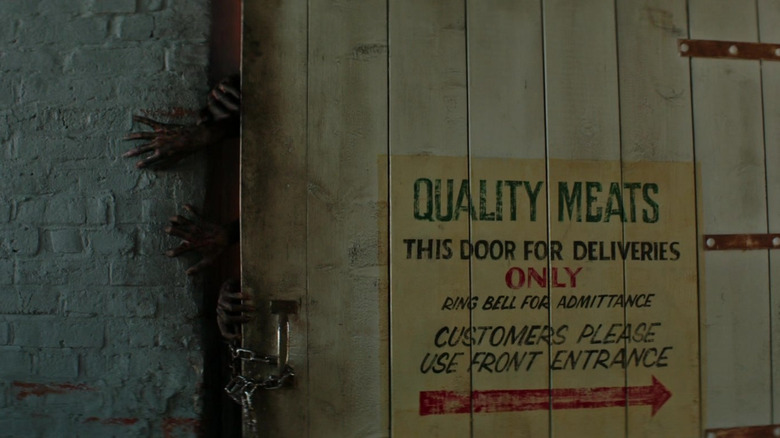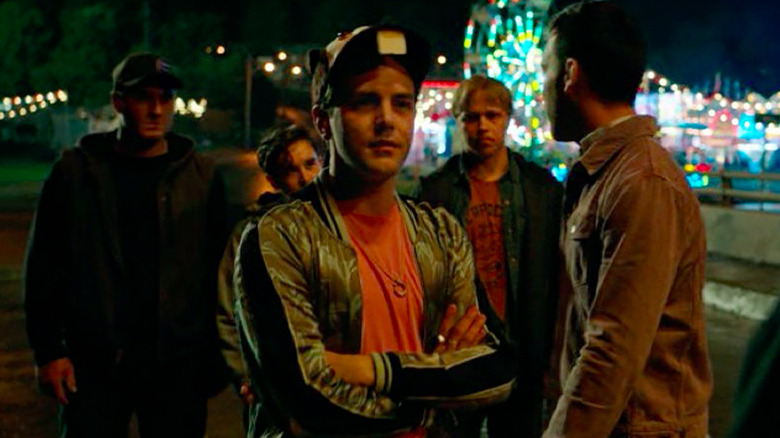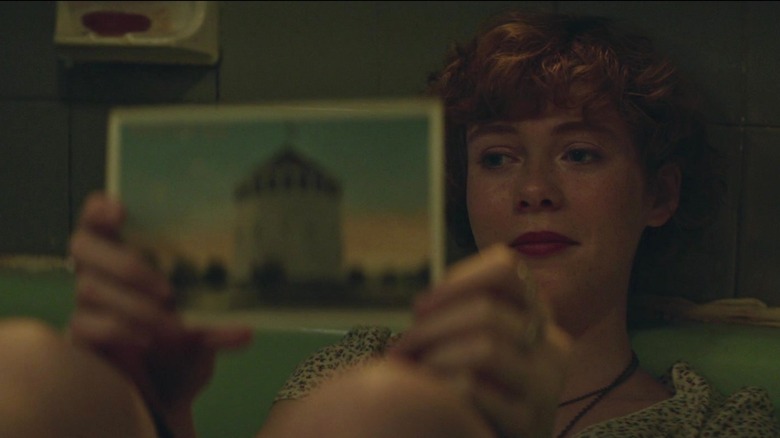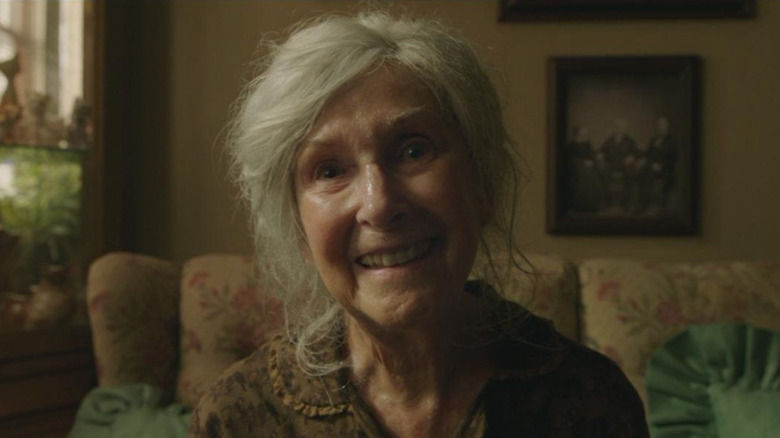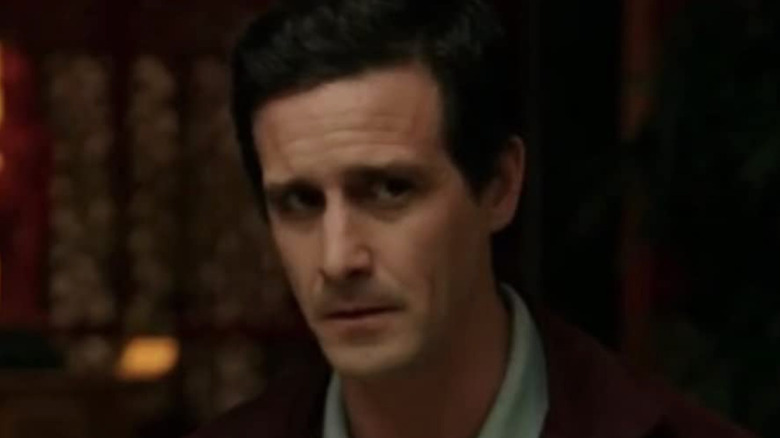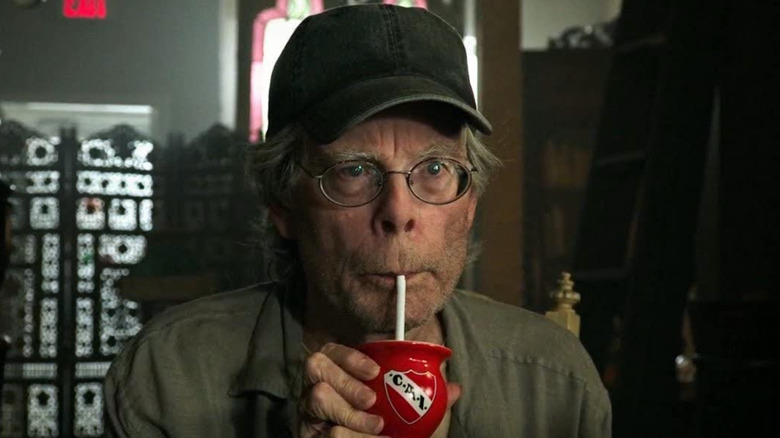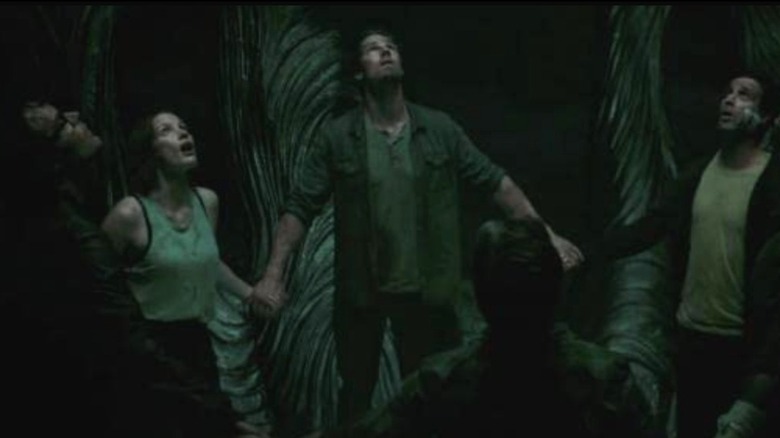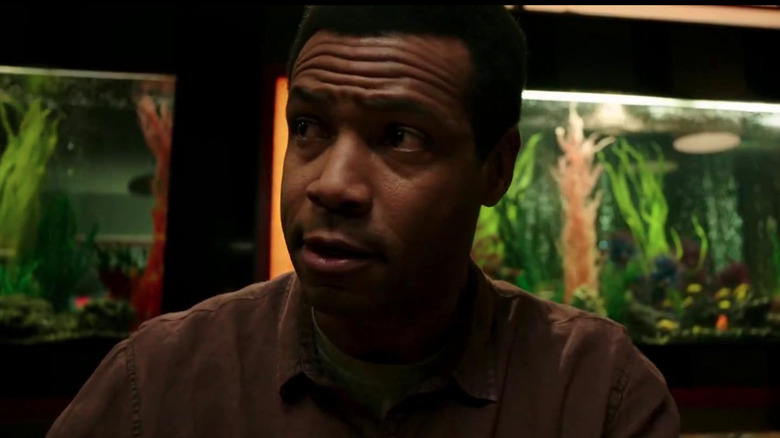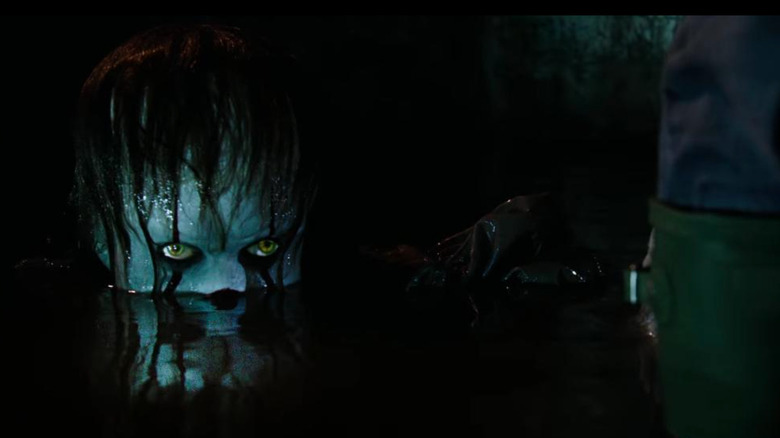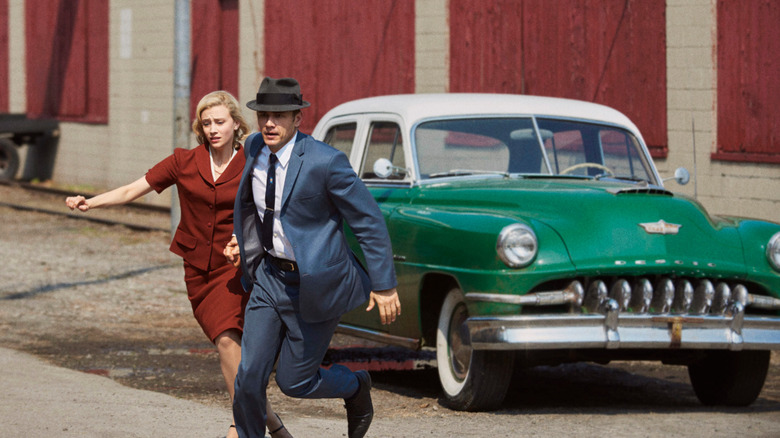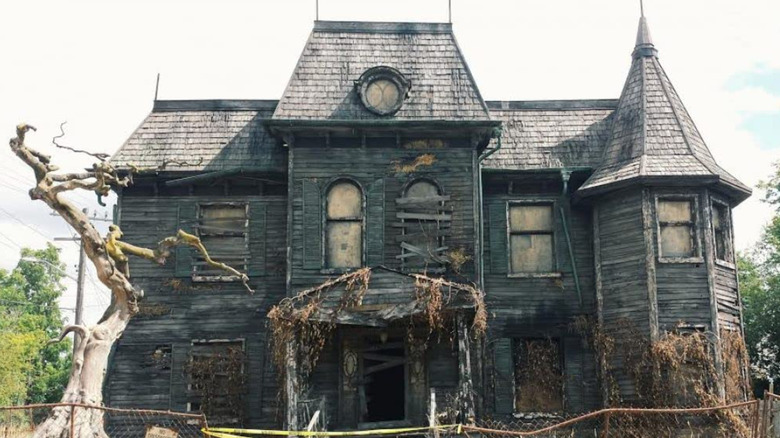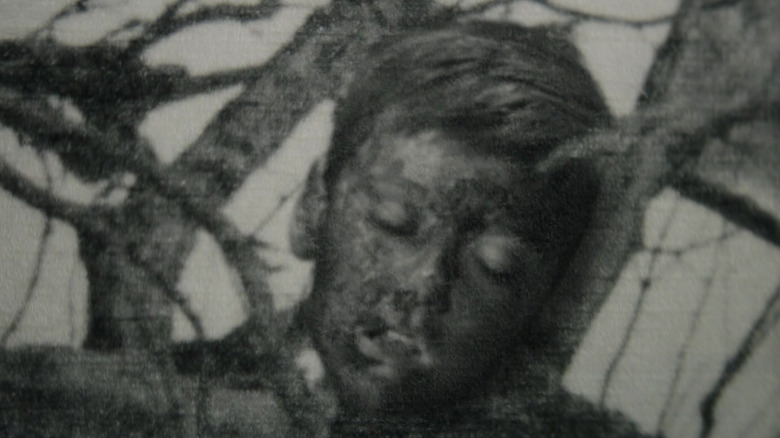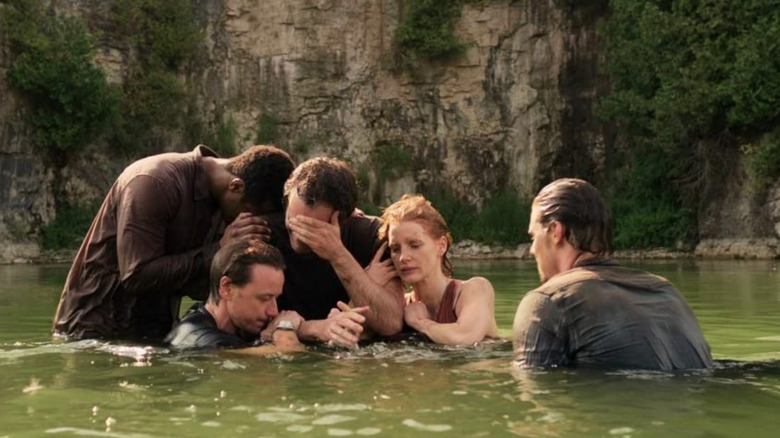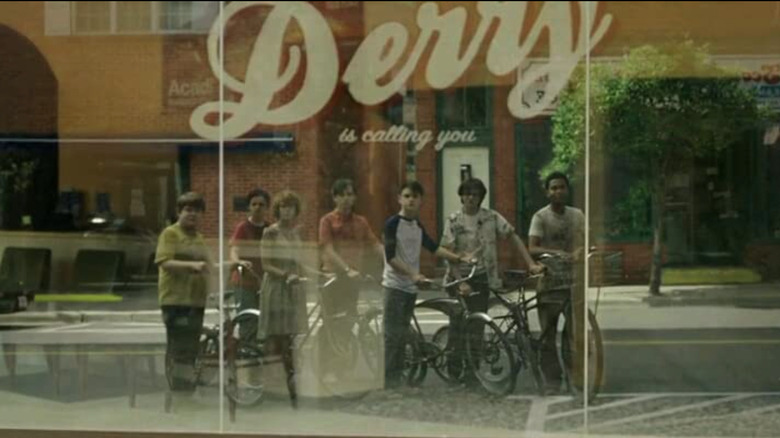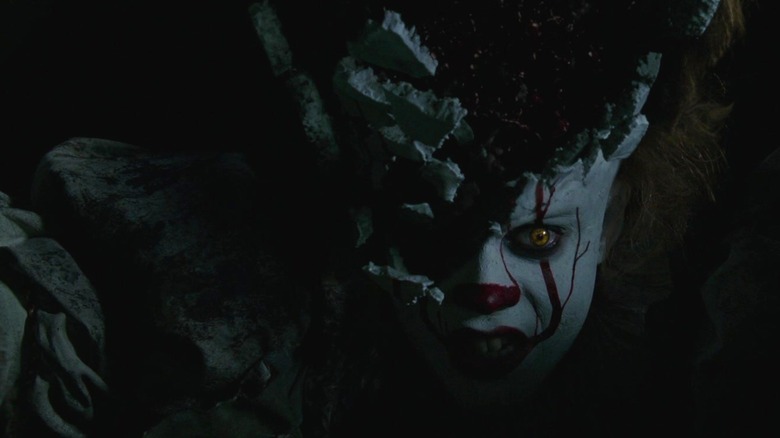IT Mysteries That'll Haunt Us Until The TV Show
It looks like we won't have to wait 27 more years to return to Derry, Maine. In late March 2022, news broke of a series in development at HBO called "Welcome to Derry." Though few details are known at this time, the show will be a prequel to Andy Muschietti's two-part adaptation of Stephen King's bestselling novel "It." In the first film, Bill, Beverly, Mike, Eddie, Ben, Stan, and Richie — a group of pre-teen outcasts who call themselves the Losers' Club — must battle a shapeshifting monster named Pennywise the Dancing Clown who preys on the children of their hometown. "It Chapter Two" sees the Losers return to Derry as adults, bound by a blood oath to come back if it turns out their nemesis is not actually dead.
Rumored to be set in the 1960s, before the events of King's novel, "Welcome to Derry" will probably not include the Losers' Club. Still, Bill Skarsgård may return as the titular clown and the series will possibly feature an origin story of his terrifying persona. Barbara Muschietti will reportedly co-produce along with her brother and Jason Fuchs who will pen the script, ensuring a seamless tonal transition between formats. No release date has been set as the project is still in development, but Constant Readers will no doubt be excited about a return to the cursed town and the possibility of answers to many of the questions that have been haunting us since the conclusion of "It Chapter Two."
Will we ever see the Interludes?
Stephen King's "It" is a masterpiece of horror fiction and an astounding literary achievement. The massive novel manages to carry seven different main characters at two stages in their lives in addition to a fascinating central villain, the titular clown. A major strength of the novel is the town of Derry itself, which becomes its own character through King's rich descriptions. The small Maine town is brought to fascinating life through a series of Interludes, a chronicle of the horrific tragedies caused by several of It's 27-year cycles when it arises from slumber to feast on the town's children.
These stories are collected by Mike Hanlon, a local librarian and the only member of the Losers' Club to remain in Derry. The Interludes include stories of mass disappearances, family annihilators, explosions, hate crimes, and massacres. Given the already exorbitant run time of both films, it's no wonder Andy Muschietti chose to excise these stories from the scripts. Though, some elements did make it into the final cut. The death of Mike's parents in a house fire is a nod to the Fire of the Black Spot, and the headless boy that haunts Ben is a victim of the Easter day explosion at the Kitchener Ironworks. News of a potential series brings hope that Constant Readers may finally see more of these brutal stories brought to life. Perhaps the series will feature a young Branson Buddinger who's "A History of Old Derry" forms the basis of Mike's research.
What happens to Adrian Mellon's killers?
"It Chapter Two," and It's second murderous cycle begins with a brutal hate crime, the murder of Adrian Mellon. While enjoying a date with his boyfriend at the local fair, three teenagers harass and attack the couple, throwing Mellon over a bridge into the rushing river below. Though he survives the fall, he winds up in the clutches of Pennywise, who lifts him from the river and takes a bite out of his ribcage. The scene is extremely upsetting, especially considering it was inspired by the real-life murder of Bangor resident Charlie Howard in 1984.
While Mellon's story is not shown in the 1990 miniseries, director Andy Muschietti felt it was important to include it in his adaptation, calling it an "essential part of the story." But Muschietti leaves this plotline with Mike receiving Pennywise's message for the now-adult Losers' Club to "come home." The last we see of the teen murderers, they're escaping into the fair's crowded streets. King's novel follows the aftermath of the crime and the subsequent questioning of the three suspects. All reports of a clown are dismissed and the three teens are convicted of murder with sentences ranging from juvenile detention to 15 years at Shawshank Prison. Had Muschietti chosen to extend the story, he likely would have followed King's narrative. However, given the brutality of the attack and the scene's shocking nature, it would be nice to see some kind of on-screen closure.
If you or a loved one has experienced a hate crime, contact the VictimConnect Hotline by phone at 1-855-4-VICTIM or by chat for more information or assistance in locating services to help. If you or a loved one are in immediate danger, call 911.
What does Ben remember about Beverly?
One of the novel's most compelling elements of Stephen King's "It" is the love triangle between Bill, Beverly, and Ben. Bill is the de facto leader of the Losers' Club and Beverly's crush. He likes her, too, and their flirtation is a beautiful depiction of young love. But Ben also has feelings for the vivacious redhead and the heartbreak of his unrequited crush is equally relatable. He sends her a beautiful haiku describing her hair as "winter fire," a line that will come to symbolize their connection, and Ben also kept a memento that he keeps close at hand.
Before meeting the rest of the Losers, young Ben spends his days alone in the library. He has a chance encounter with Beverly and she becomes the only person to sign his yearbook. As an adult, he keeps the page folded in his wallet as a memento of his first love. Though this is an undoubtedly sweet addition to King's original story, it raises an inconvenient question. Once the Losers leave Derry, their memories of the summer of 1989 begin to fade. Ben, however, has kept the name of one of the Losers at his fingertips for the last 27 years. Has he remembered Beverly all this time? If so, what else does he remember? Perhaps, like Beverly, he doesn't remember the origin of the sweet message, only how it makes him feel, a reminder that when he felt most alone in the world, he had a friend.
Who is Mrs. Kersh and who is her father?
Trying to remember her forgotten childhood in Derry, an adult Beverly visits her father's apartment and has a terrifying encounter with the new resident. The old lady who answers the door introduces herself as Mrs. Kersh (Joan Gregson). She informs Beverly that her father has passed away and then invites her in for tea and cookies. While Beverly explores her former home, Mrs. Kersh reminisces about her "fadder," a sinister-looking man who joined a traveling circus. She emerges from the shadows naked and rapidly growing as she chases Beverly through the apartment. As Beverly flees, she encounters a man putting on clown makeup. Is this Robert Gray, Mrs. Kersh's father and one of It's alter egos?
Neither the film nor its source material give definitive answers on this horrifying pair, but Gregson has confirmed that her character is Pennywise's daughter. While definitely intriguing, this familial revelation poses more questions than it answers. Is Mrs. Kersh the daughter of Robert Gray or of It himself, referencing It's reproductive abilities described in King's novel? Is she a shape-shifting monster in her own right, or merely another face Pennywise dons to terrify his victims? Set in the 1960s, "Welcome to Derry" would present a perfect opportunity for a storyline featuring younger Mrs. Kersh and Robert Gray, answering some of the many questions this terrifying scene brings to mind.
What's the significance of Angel of the Morning?
James Ransone's performance as Eddie Kaspbrak is one of the bright spots of "It Chapter Two." His resemblance to Jack Dylan Grazer, playing his younger persona, is uncanny and Ransone perfectly captures the often comic intensity Grazer brought to the first film. He adds similar humor here and his chemistry with Bill Hader as an adult Richie Tozier provides some of the film's funniest moments. However, not all of the jokes land and the most disgusting one is downright perplexing.
While visiting the pharmacy to pick up an inhaler, Eddie hears suspicious sounds coming from the basement. The timelines blur and a young Eddie remembers finding his mother trapped in the basement as the leper, his own personal boogeyman. As a child, Eddie is unable to save her, but his adult self gets a chance to confront this frightening memory. As he throttles the leper, he spews an incredible amount of black vomit directly into Eddie's face while the chorus to Juice Newton's "Angel of the Morning” blasts in accompaniment.
It's a jarring scene and most likely a reference to Stephen King's "The Langoliers," the lead novella in "Four Past Midnight." The story's central antagonist, Craig Toomey, connects the song to traumatic childhood memories with his unstable mother, similar to the trauma Eddie suffers in his own mother's home. Though the thematic parallel is sound, the reference is perhaps a bit too obscure leaving everyone but the most eagle-eyed Constant Readers scratching their heads.
Are Stephen King's endings really that bad?
With an estimated 350 million books sold, Stephen King ranks among the world's most successful living authors. The king of horror has still faced his share of criticism, though. Chief among them is the oft-repeated claim that he struggles to write satisfying conclusions to his novels, especially the long ones. While this is hardly a universal opinion, two notorious examples are "The Stand," with a climax involving the literal hand of God, and "It," whose Ritual of Chüd left many readers confused. The critique is so pervasive that the host of the Stephen King Cast reinvented his format to analyze each book's ending and examine the veracity of the claim.
Fair or not, the reputation was clearly on Gary Dauberman's mind when writing the script for "It Chapter Two." Multiple characters comment on Bill Denbrough's inability to stick to his literary landings; even his wife Audra confesses to not liking them. Bill is one of many writer protagonists in King's canon and it's no stretch to interpret the character as semi-autobiographical. Always a good sport, King is even in on the joke and provides a delightful cameo as the proprietor of the junk shop in which Bill finds his childhood bike. King's character declines Bill's autograph because he "didn't like the ending" of his most recent book. While opinions on the quality of a conclusion will always be subjective, this running joke is a cheeky way of confronting a critique that's plagued the author throughout his career.
Why doesn't the Ritual of Chüd work?
Speaking of endings, the climax of Stephen King's novel involves the Ritual of Chüd, a metaphysical battle of wills that's as difficult to describe as it is to envision. Andy Muschietti's adaptation, "It Chapter Two," keeps the ritual's name, but little else. His version requires each Loser to retrieve a token of their time in Derry, a physical manifestation of their bond with the group, that they will burn in an urn-like artifact Mike took from the Native tribe that originally taught him the ritual. They hold hands and chant, attempting to trap It and the Deadlights within the ancient container. The ritual is a failure, and a massive red balloon emerges from the artifact signaling a Pennywise stronger than ever. He mocks them and reveals the deaths of the entire tribe while trying to complete the ritual.
Deviations from the source material aside, it's worth asking why the ritual doesn't work. Or perhaps the better question is whether Mike actually believes it will. Muschietti has implied that the Club's historian uses the ritual as a sort of token to unite the Losers in the belief that killing It is possible, saying, "He knows that the only way to defeat Pennywise is using the power of unified belief and this is the McGuffin that he decides to use." Producer Barbara Muschietti has alluded to a longer version of the ritual that may be included in an extended cut, possibly providing more answers.
Why are they so mean to Mike?
While director Andy Muschietti does a remarkable job capturing the heart of Stephen King's story, some fan-favorite scenes missed the final cut. While this is understandable given the novel's 1,138-page length, one character, in particular, gets short shrift. Mike has very little to do in the first film; his happy family is replaced with a tragic story of a child orphaned in a house fire. Mike is the historian and researcher, a role given to Ben for some reason, further limiting any contributions he might make to the group. But Mike faces an even tougher arc in "It Chapter Two" and becomes a metaphorical punching bag for the rest of the group.
As the sole Loser to remain in Derry, Mike is tasked with maintaining a lookout should Pennywise ever return. He is the lighthouse, unable to forget the traumatic summer of 1989 and burdened with the responsibility of summoning the rest of the club to a reunion that may lead to their deaths. His friends seem to be angry with him for holding him to the promise instigated by Bill, and they take their frustration out on him whenever possible. The script puts him in a poor position as well as he frequently resorts to deceit in order to remind them of the oath they all swore and to help them understand what they're up against. King's Mike feels like the moral center of the story, a depiction in wild contrast to Muschietti's version of the character.
Will we ever meet Maturin?
One of the most exciting aspects of the upcoming "Welcome to Derry" series is the promise of It's origin story. Given the series' rumored 1960s setting, an explanation of the origins of the galaxy seems unlikely, but one never knows in a story built on shifting timelines. With a backstory for Pennywise comes the hope that we might finally see an onscreen depiction of Maturin. In Stephen King's connected world, the grandfatherly turtle is a being perhaps even older than It and a guardian of the beams that support The Dark Tower. Kind though disinterested, he is It's adversarial brother and counsels the Losers before their first attempt at the Ritual of Chüd.
Maturin does not make a formal appearance in Andy Muschietti's films, but his presence is felt throughout the story. These references are most noticeable in the first film when Bill picks up a lego turtle in Georgie's bedroom, and the kids mention finding a live turtle while swimming in the quarry. More stealthy references include turtle imagery at school and in front of Ben's adult home, along with the hallucinogenic root Mike gives Bill, called Maturin. King's novel notes that the god-like turtle has died by the time the Losers return to Derry as adults, but a prequel series could possibly include a depiction of It's half-shelled brother.
Will we see Jake Epping?
Stephen King loves to revisit the cursed town of Derry and has set a number of subsequent novels and short stories within its borders. One reappearance occurs in King's time travel adventure tale "11/22/63." Jake Epping is an English teacher who uses a mysterious portal to travel back to 1958 in order to stop the assassination of John F. Kennedy. Though the portal is located in the neighboring town of Lisbon Falls, Jake makes a trip to Derry in order to prevent another tragedy. While there, he stumbles upon two Losers, Beverly and Richie, practicing for a swing dance competition in the Barrens. It's a sweet scene and a love letter to Constant Readers who adored the chance to revisit these beloved characters in happier times.
While Jake doesn't spend much time in Derry, finding the town too unpleasant to set down permanent stakes, he does remain in the past for the next five years preparing for the fateful day in Dallas. Depending on when "Welcome to Derry” is set, George could conceivably be living in Jody, Texas, and preparing for his appointment with Lee Harvey Oswald. It's reasonable to assume that he might make a road trip back to the Maine town. Or, perhaps we will run into Al Templeton, the ill-fated proprietor of the diner housing the portal's entrance. What King's historical novel makes clear is that though the past may be obdurate, anything is possible.
What do the Neibolt Street neighbors think?
The house on Neibolt Street is one of the most terrifying locations in all of Stephen King's canon. Known as the Well House in Andy Muschietti's films, it hides the most direct entrance to Pennywise's lair. The abandoned house looks almost comically haunted with a decaying exterior and rooms filled with his deadly traps. After the Losers defeat It as adults, the house begins to collapse in on itself, sinking into the ground as Pennywise's lair breaks apart. Though we mostly see the house on Neibolt Street in isolation or from within, it is part of a Derry neighborhood. What must the neighbors think of the dilapidated house on the corner of their street?
This line of thinking invites many more questions about what it's like to live next door to Pennywise. Do the Neibolt Street neighbors ever see the clown lurking in the yard? Do they catch glimpses of the leper wandering up and down the street? The house probably falls under the spell of indifference Pennywise has cast on the town, allowing neighbors to ignore any strange occurrences they may see or hear. It's also possible that this was the one time home of Bob Gray, abandoned since his time in the circus. Maybe we'll see a less decrepit Well House in the upcoming "Welcome to Derry," but for now we'll just have to content ourselves with wondering what stories the Neibolt Street Nextdoor app might contain.
What's Derry like between cycles?
Our time spent in Derry begins and ends with two cycles, one set in 1989, and the other 27 years later. Though the pages of Stephen King's novel contain more information, we still learn little about the town during the years when It lies dormant. Derry is filled with It's pervasive evil, causing the adults to be callous, neglectful, and even violent. But all evidence of this occurs within the cycles. What about the years before and after? Are the residents safe while Pennywise sleeps? Could they survive simply by taking an extended vacation every 27 years? Or does the evil persist through the off years as well? Maybe the real question is, will anyone ever truly be safe in Derry, Maine?
King hints at an answer to this question with an extended return to the town in his time-bending novel "11/22/63." Jake Epping finds himself exploring Derry shortly after the end of the 1958 cycle and senses an ominous presence in the ruins of the Kitchener Ironworks explosion. He describes what he assumes is the true nature of Derry itself: "... Hibernating. Letting people believe the bad times were over, waiting for them to relax and forget there had ever been bad times at all." There's no word yet on whether "Welcome to Derry" will feature a formal cycle of It's activity, but we may see residents lulled into a false sense of security, sitting ducks unaware of the evil preparing to strike.
What about Eddie's body?
It's easy to see Eddie as the heart of the Losers' Club. Overly cautious, the intense but funny hypochondriac is always on high alert for danger and usually prepared with a fanny pack full of first aid supplies. He is also the focus of one of the series' most heartbreaking moments in which the remaining Losers grieve his death while embracing in the quarry. Eddie delivers the killing blow to It, believing his spear capable of killing monsters, and has turned around to celebrate with Richie when he's impaled by one of Pennywise's flailing tentacles. He dies during the final showdown, and the remaining Losers must leave his body behind in It's crumbling lair.
Though heartbreaking in its own right, the location of Eddie's body brings to mind Mrs. Kersh's ominous statement about Derry: "No one who dies here ever really dies." Will Eddie's body be safe since It's spell has been presumably broken, or will he become a vessel for another monster? And what will they tell his wife Myra? The child of an extremely needy and overprotective mother, Eddie has grown up to marry a woman just like her. In fact, both Mrs. Kaspbraks are played by the same actress. In the novel, Myra is devastated when her husband leaves for Maine, an overreaction to be sure, but in this case, she's right to be scared. Eddie will not be coming back from his reunion trip. What will they tell her? And will Myra accept their answer?
Will the Losers forget again?
"It Chapter Two" begins with most of the Losers' Club remembering the events of the first film. Having left Derry, they've forgotten the incredible battle they waged against the shapeshifting monster. Mike is the only one to remember, staying behind to keep watch for It's possible return. Andy Muschietti's film ends with the Losers intertwining their lives, intentionally staying in touch, and remembering their connection. Mike leaves Derry for good, hopefully, able to enjoy the same success the rest of his friends have found. Bill is writing a new story and feeling more confident about his conclusion. Beverly and Ben leave together, planning to start a new life, and Richie finally admits the truth about the secret he's been hiding since childhood. As they all leave Derry, the question arises, will they continue to remember what happened, or will they eventually forget again?
In Stephen King's novel, the adults begin to forget each other as they slowly move on with their lives, a bittersweet reminder that everything fades away with time. After all, can any of us truly remember every moment of our past? When recalling the poem Ben sent her, Beverly says she doesn't know who wrote it, only how it made her feel. Perhaps this is what the Losers can hold onto even if they forget the details of their story. Maybe the memory that will stick is the bond they once shared and the ways they stood up for each other in their lowest moments.
Is Pennywise really dead?
Of all the questions posed by "It Chapter Two," this is perhaps the most important. After everything the Losers have been through, after everything they've sacrificed, were they actually successful? Is Pennywise really dead? The film concludes with the Losers making the clown small by refusing to be afraid. They rip out his heart and crush it together, watching the pieces of It float up into the Macroverse from which they came. The Well House crumbles and their scars fade. But if Pennywise is a personification of evil and fear, can those two things ever truly die?
Stephen King would continue to return to Derry in many subsequent novels and stories, but in his 2001 novel "Dreamcatcher," we find a potential answer to this question. In another story about childhood friends reuniting as adults, Jonesy and Mr. Gray visit the site where the Standpipe once stood and find a memorial to the many victims of Pennywise. The memorial plaque is signed with the names of each member of the Losers' Club, but another message provides an ominous warning. When reading the Losers' message on the memorial plaque, Mr. Gray notes, "Spray-painted across it in jagged red letters, also perfectly visible in the truck's headlights, was this further message: PENNYWISE LIVES." Given what the novel reveals about Mr. Gray, it's possible to read him as another manifestation of It's evil. With roughly 24 years to go before It's next cycle is due, we'll have to wait to see if King's iconic villain will live to see another day.
